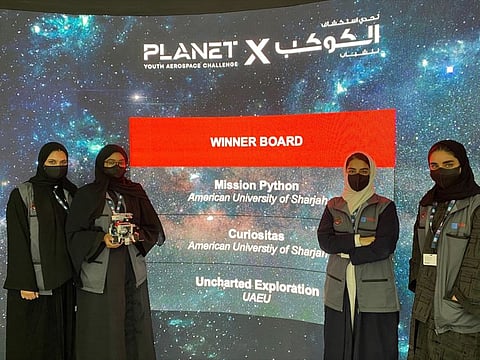UAE University team wins third place in ‘Planet X' exploration challenge
Team designs exploration drone and unmanned ground vehicle to study model planet

Al Ain: A student team from United Arab Emirates University (UAEU) recently won third place in the ‘Planet X Challenge’ organised by Emirates Mars Mission (EMM) in partnership with Dubai Airshow.
The winning UAEU students are Alia Mohammad Fairouz (College of Information Technology); Mahra Al Muqbali (College of Engineering), Raya Saeed Al Khateri and Jawaher Rashid Al Nuaimi (both from College of Science).
They participated in competitions and challenges by accomplishing five tasks set to explore ‘Planet X’, such as designing an unmanned aerial vehicle (UAV) with a 3D printing system and making a presentation on how it fits into the atmosphere of the planet and carrying out the assigned tasks on Planet X.
The multidisciplinary competition provided opportunities for young people to engage in an experience to build a mission to discover a new planet, during a two-month period dedicated to designing and programming robots for space exploration, in order to contribute to the country’s scientific progress in the fields of space and aviation.
Studying the surface
The tasks include transporting a box with samples from the planet and landing them on the ‘Heli Pad’. In the second stage of the competition, the UAEU team designed a robot using EV3-kit technology, and created additional accessories to carry out specific tasks on the planet, including moving and loading rocks on Planet X.
Challenges
UAEU said the team was tasked to design an unmanned ground vehicle to study the surface of Planet X and find a sample collection site using the Lego Mindstorms EV3, according to different programming levels between high school and university students.
All robots had sensors and engines, and teams were given five minutes to complete a pilot simulation task without any support or assistance.
The second challenge was to design an unmanned aerial vehicle to carry out exploration missions, using CAD Fusion 360 model programme.
Sign up for the Daily Briefing
Get the latest news and updates straight to your inbox



